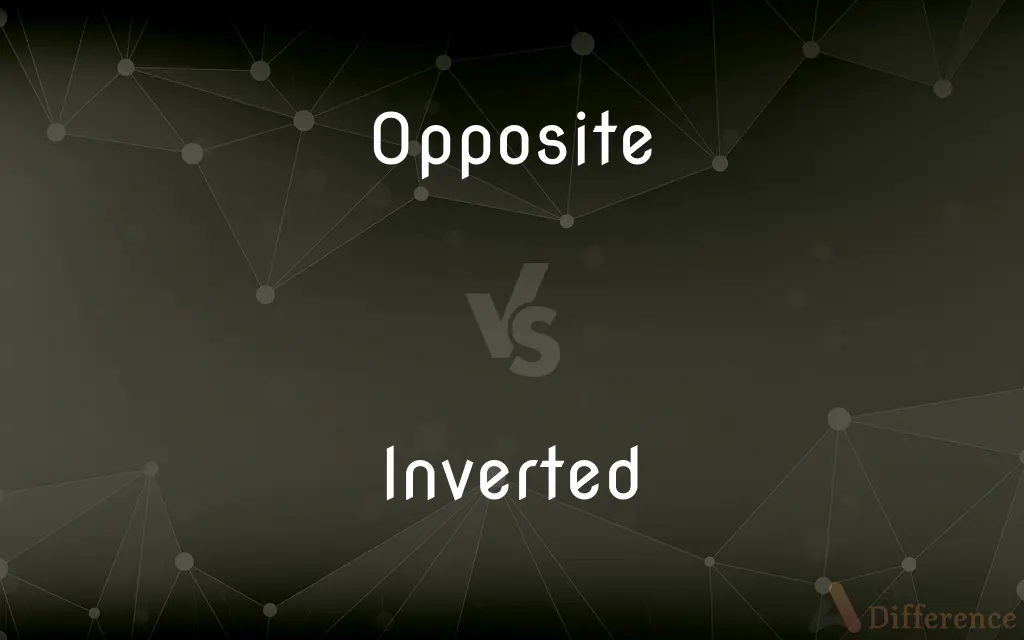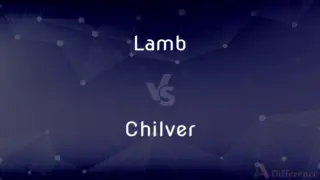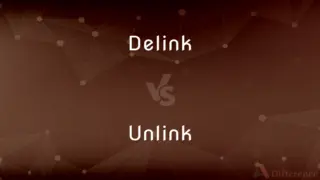Opposite vs. Inverted — What's the Difference?
By Fiza Rafique & Urooj Arif — Updated on April 26, 2024
Opposite refers to things diametrically different or contrary, while inverted indicates something turned upside down or inside out.

Difference Between Opposite and Inverted
Table of Contents
ADVERTISEMENT
Key Differences
Opposite often describes a position, direction, or concept that is completely different from another, creating a direct contrast. Whereas inverted focuses on the physical orientation being reversed, such as flipping or rotating an object.
In terms of ideas or abstract concepts, opposite denotes direct contradiction, like in opposite opinions or stances in a debate. On the other hand, inverted is less about opposition in ideas and more about reversal in order or arrangement, such as an inverted sentence structure in grammar.
When used in geometry, opposite angles are those formed by two intersecting lines and are equal in measure. In contrast, an inverted figure in geometry might refer to a shape or object that has been turned over along an axis.
In color theory, opposite colors are those directly across from each other on the color wheel, providing maximum contrast and complementarity. Conversely, inverted colors in digital graphics refer to the colors that are negatives of each other based on the color spectrum used in technology.
In language and semantics, opposites are pairs of words with contrasting meanings, like "hot" and "cold". Meanwhile, inverted can describe a scenario where typical word order is reversed for stylistic effect or emphasis, changing the usual syntactic structure.
ADVERTISEMENT
Comparison Chart
Definition
Refers to a direct contrast or opposition.
Describes the reversal of position or order.
Usage in Language
Used to denote antonyms or contradictory concepts.
Used for reversed order, like in syntax.
Usage in Geometry
Pertains to angles or positions directly across.
Refers to shapes or figures turned over.
Usage in Color Theory
Relates to colors directly across on a color wheel.
Pertains to the negative version of colors in graphics.
Conceptual Application
Often used in abstract or conceptual oppositions.
Generally relates to physical or structural reversals.
Compare with Definitions
Opposite
Diametrically different in position or direction.
North is opposite to south.
Inverted
Made to function in a reversed manner.
Inverted controls can confuse new players.
Opposite
Inverse or completely different in effect.
The medicine had the opposite effect.
Inverted
Turned upside down or reversed in order.
An inverted image appears as though it's flipped vertically.
Opposite
Situated directly across from something else.
She sat opposite him at the table.
Inverted
Changed to the opposite arrangement or sequence.
The phrase uses inverted syntax for emphasis.
Opposite
Contrary in nature or characteristics.
Their opinions are opposite.
Inverted
Flipped over along an axis.
The diagram shows an inverted triangle.
Opposite
Antonymous, as in words or phrases.
High is the opposite of low.
Inverted
Converted into its negative form, particularly in colors.
The inverted color scheme is used for special effects.
Opposite
Placed or located directly across from something else or from each other
Opposite sides of a building.
Inverted
To turn inside out or upside down
Invert an hourglass.
Opposite
Facing the other way; moving or tending away from each other
Opposite directions.
Inverted
To reverse the position, order, or condition of
Invert the subject and predicate of a sentence.
Opposite
Altogether different, as in nature, quality, or significance
The effect of the medication was opposite to that intended.
Inverted
To subject to inversion.
Opposite
Sharply contrasting; antithetical
Had opposite views on the subject.
Inverted
To be subjected to inversion.
Opposite
Growing in pairs on either side of a stem
Opposite leaves.
Inverted
Something inverted.
Opposite
Arranged on the same radius as another part, as stamens and petals.
Inverted
Having the order or direction changed; for example turned upside down, reversed or in any other way opposite or contrary.
Opposite
One that is opposite or contrary to another.
Inverted
(music) (of a chord) Having the lowest note transposed an octave higher.
Opposite
An opponent or antagonist.
Inverted
(chemistry) (of sugar) Having its polarization changed by hydrolysis; see invert sugar.
Opposite
An antonym.
Inverted
Simple past tense and past participle of invert
Opposite
In an opposite position
They sat opposite at the table.
Inverted
Changed to a contrary or counterchanged order; reversed; characterized by inversion.
Opposite
Across from or facing
Parked the car opposite the bank.
Inverted
Situated apparently in reverse order, as strata when folded back upon themselves by upheaval.
Opposite
In a complementary dramatic role to
He played opposite her.
Inverted
Being in such a position that top and bottom are reversed;
A quotation mark is sometimes called an inverted comma
An upside-down cake
Opposite
Located directly across from something else, or from each other.
She saw him walking on the opposite side of the road.
Inverted
(of a plant ovule) completely inverted; turned back 180 degrees on its stalk
Opposite
(botany) Of leaves and flowers, positioned directly across from each other on a stem.
Opposite
Facing in the other direction.
They were moving in opposite directions.
Opposite
Extremely different; inconsistent; contrary; repugnant; antagonistic.
Opposite
Something opposite or contrary to something else.
Opposite
A person or thing that is entirely different from or the reverse of someone or something else; used to show contrast between two people or two things.
She is the opposite of her ex-boyfriend who abused her both physically and verbally nearly every day for five years. She now works as an advocate and supportive listener for others who have endured abusive relationships.
Opposite
An opponent.
Opposite
An antonym.
"Up" is the opposite of "down".
Opposite
(mathematics) An additive inverse.
Opposite
In an opposite position.
I was on my seat and she stood opposite.
Where's the bus station? -Over there, just opposite.
Opposite
Facing, or across from.
He lives opposite the pub.
Opposite
In a complementary role to.
He played opposite Marilyn Monroe.
Opposite
(television) On another channel at the same time.
The game show Just Men! aired opposite The Young and the Restless on CBS.
Opposite
Placed over against; standing or situated over against or in front; facing; - often with to; as, a house opposite to the Exchange; the concert hall and the state theater stood opposite each other on the plaza.
Opposite
Situated on the other end of an imaginary line passing through or near the middle of an intervening space or object; - of one object with respect to another; as, the office is on the opposite side of town; - also used both to describe two objects with respect to each other; as, the stores were on opposite ends of the mall.
Opposite
Extremely different; inconsistent; contrary; repugnant; antagonistic.
Novels, by which the reader is misled into another sort of pleasure opposite to that which is designed in an epic poem.
Particles of speech have divers, and sometimes almost opposite, significations.
Opposite
Set over against each other, but separated by the whole diameter of the stem, as two leaves at the same node.
Opposite
One who opposes; an opponent; an antagonist.
The opposites of this day's strife.
Opposite
That which is opposed or contrary in character or meaning; as, sweetness and its opposite; up is the opposite of down.
The virtuous man meets with more opposites and opponents than any other.
Opposite
Two words that express opposing concepts;
To him the opposite of gay was depressed
Opposite
A relation of direct opposition;
We thought Sue was older than Bill but just the reverse was true
Opposite
A contestant that you are matched against
Opposite
Something inverted in sequence or character or effect;
When the direct approach failed he tried the inverse
Opposite
Being directly across from each other; facing;
And I on the opposite shore will be, ready to ride and spread the alarm
We lived on opposite sides of the street
At opposite poles
Opposite
Of leaves etc; growing in pairs on either side of a stem;
Opposite leaves
Opposite
Moving or facing away from each other;
Looking in opposite directions
They went in opposite directions
Opposite
Altogether different in nature or quality or significance;
The medicine's effect was opposite to that intended
It is said that opposite characters make a union happiest
Opposite
Characterized by opposite extremes; completely opposed;
In diametric contradiction to his claims
Diametrical (or opposite) points of view
Opposite meanings
Extreme and indefensible polar positions
Opposite
Directly facing each other;
The two photographs lay face-to-face on the table
Lived all their lives in houses face-to-face across the street
They sat opposite at the table
Common Curiosities
Can the term "inverted" apply to ideas or theories?
While less common, "inverted" can apply to ideas or theories where traditional concepts are reversed or turned upside down to provide a new perspective.
How do inverted colors function in digital media?
Inverted colors in digital media switch all colors to their respective complementary colors on the color wheel, often used for visual effects or accessibility features like night modes.
What is the opposite of a given number in mathematics?
The opposite of a given number is its additive inverse, which means it has the same magnitude but the opposite sign, ensuring that their sum is zero.
Is "opposite" used in mathematics?
Yes, "opposite" is used in mathematics to describe numbers or quantities that are equal in magnitude but differ in sign, like +5 and -5.
What is an example of an inverted sentence structure?
An inverted sentence structure may place the verb before the subject, often for stylistic effect, such as "Rarely have I seen such courage."
What does it mean when figures are opposite in geometry?
In geometry, opposite figures or angles are those that lie across from each other at an intersection or within a shape, typically mirroring or directly contrasting each other.
Can the concept of "opposite" apply to physical movements or actions?
Yes, the concept of "opposite" can apply to physical movements or actions, such as in opposite directions of motion or movements that counteract each other.
How are inverted sequences used in writing?
Inverted sequences in writing often involve flipping the conventional order of words or phrases, enhancing dramatic effect or emphasizing a point, commonly seen in poetic or rhetorical compositions.
What defines opposite angles in geometry?
Opposite angles, also known as vertical angles, are formed when two lines intersect, creating pairs of angles that are equal in measure and directly across from each other at the vertex.
How do opposite concepts aid in understanding abstract theories?
Opposite concepts help in understanding abstract theories by providing a clear dichotomy or contrast, which can simplify complex ideas by comparing and contrasting their defining characteristics.
How does one identify opposite words in language learning?
Opposite words, or antonyms, can be identified in language learning by their contrasting meanings, helping to expand vocabulary and enhance understanding of nuanced language use.
In what scenarios might colors be inverted intentionally?
Colors might be inverted intentionally in scenarios involving visual arts and digital media to create specific effects, highlight contrasts, or accommodate visual impairments.
Why might one choose to use an inverted structure in music composition?
In music composition, an inverted structure might be used to create variation and complexity, modifying a theme by reversing its melody or bass line to produce a new but related musical idea.
What are common uses of inverted formats in technology?
Inverted formats in technology are often used to improve usability or aesthetics, such as inverted color schemes for easier reading under low light conditions or inverted controls in user interfaces for specific accessibility needs.
Are there any psychological theories that involve opposites?
Yes, some psychological theories involve opposites, such as the Jungian theory of psychological types, which considers opposite traits within personalities, like introversion versus extroversion, to explain human behavior.
Share Your Discovery

Previous Comparison
Lamb vs. Chilver
Next Comparison
Delink vs. UnlinkAuthor Spotlight
Written by
Fiza RafiqueFiza Rafique is a skilled content writer at AskDifference.com, where she meticulously refines and enhances written pieces. Drawing from her vast editorial expertise, Fiza ensures clarity, accuracy, and precision in every article. Passionate about language, she continually seeks to elevate the quality of content for readers worldwide.
Co-written by
Urooj ArifUrooj is a skilled content writer at Ask Difference, known for her exceptional ability to simplify complex topics into engaging and informative content. With a passion for research and a flair for clear, concise writing, she consistently delivers articles that resonate with our diverse audience.














































